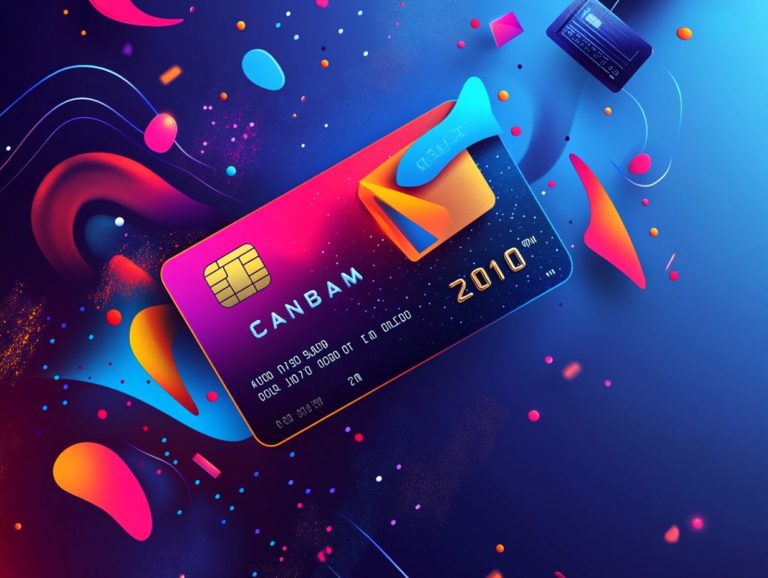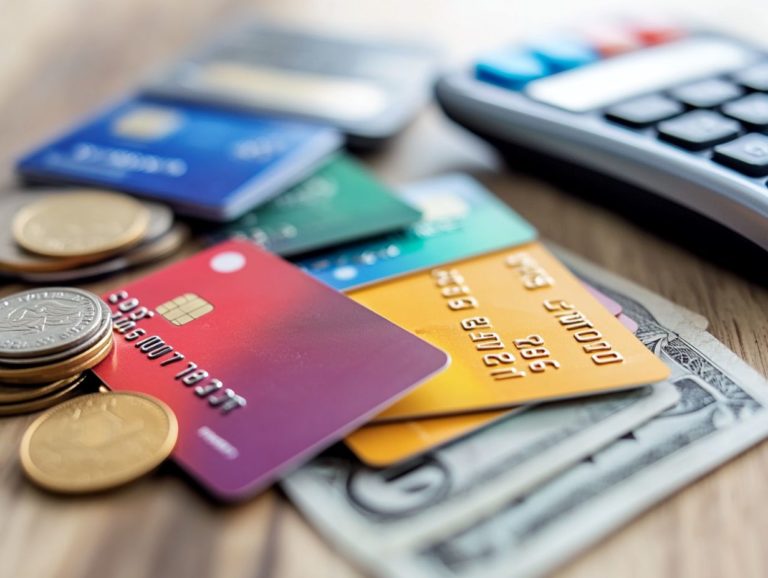How to Evaluate Cash Back Card Offers
Cash back credit cards can serve as a smart financial ally, rewarding you for your everyday expenditures.
This guide will illuminate the essentials of cash back cards, delving into what they are, the different types on the market, and how to select the one that best suits your needs. You ll discover key factors to consider, tips for maximizing your rewards, and common pitfalls to avoid.
Whether you’re a seasoned pro or just dipping your toes into the world of cash back cards, this information will empower you to make informed decisions and fully capitalize on your rewards!
Contents
- Key Takeaways:
- Understanding Cash Back Credit Cards
- Types of Cash Back Cards
- Factors to Consider When Evaluating Cash Back Offers
- Maximizing Cash Back Rewards
- Common Pitfalls to Avoid
- Frequently Asked Questions
- What are cash back card offers and how do they work?
- How do I know if a cash back card offer is right for me?
- What factors should I consider when evaluating cash back card offers?
- Are there any downsides to cashback card offers?
- How often should I review my cashback card offer?
- Can I have multiple cashback card offers?
Key Takeaways:
- Consider the annual fees and interest rates before signing up for a cash back credit card to ensure that the rewards outweigh the costs.
- Take advantage of rotating categories and fixed categories to maximize cashback rewards.
- Be cautious of hidden fees and restrictions, as well as the potential impact on your credit score when evaluating cash back card offers.
Understanding Cash Back Credit Cards
Grasping the intricacies of cash back credit cards is vital for anyone looking to get the most out of their money and meet their financial aspirations. These cards present a distinctive advantage, enabling you to earn and redeem rewards points on your daily expenditures.
With choices like the American Express Platinum Card and Chase Sapphire Preferred at your disposal, you can fully take advantage of flexible rewards and co-branded credit cards credit cards that partner with specific brands to offer rewards that align with your spending habits. Cash back programs often include attractive welcome offers and cashback rewards that can substantially boost your overall value.
Therefore, it s essential to explore all the options available in the credit card landscape.
What are Cash Back Cards?
Cash back cards are your go-to credit cards that reward you with a percentage of your purchases back in cash or points, turning your everyday spending into a delightful return. These financial gems operate on a simple principle: for every dollar you spend, you earn a set percentage back, usually between 1% and 5%, depending on what you’re buying.
For example, some issuers offer higher cash back percentages for groceries or gas, encouraging you to spend strategically. Tracking your earnings is a breeze through the card issuer’s online platform or mobile app no more guesswork here!
When it s time to redeem your cash back, you ll find the options refreshingly flexible. You can apply your rewards as statement credits, snag gift cards, or even arrange direct deposits into your bank account. It s no wonder cash back cards are a favorite for those looking to maximize their everyday purchases!
Types of Cash Back Cards
Cash back cards can be elegantly classified into several types, each tailored to meet distinct consumer spending habits and preferences. You have options like flat rate, tiered cash back, rotating categories, and fixed categories.
This variety enables you to select a card that perfectly aligns with your spending patterns, whether you favor a steady return or the allure of elevated rewards in specific areas.
Flat Rate vs. Tiered Cash Back
Flat rate cash back cards provide a consistent percentage of cash back on all your purchases, while tiered cash back cards allow you to enjoy varying rates based on the category of your spending, enabling you to maximize your rewards points according to your behavior.
For example, a flat rate card might offer a straightforward 1.5% back on every transaction, perfect for those who value simplicity in their rewards structure. In contrast, tiered cards could reward you with 5% cash back on groceries, 3% on dining, and 1% on everything else. This could be more advantageous if you find yourself spending heavily in specific areas.
Take a moment to reflect on your typical monthly expenses to figure out which type aligns best with your financial goals. If you re a high spender in targeted categories, tiered cards may offer you greater rewards, while casual spenders might prefer the dependable nature of flat rate cards.
Start exploring your options today to maximize your rewards!
Rotating Categories vs. Fixed Categories
Rotating cash back cards change eligible spending categories every quarter. This allows you to earn higher rewards points in specific areas, while fixed categories provide consistent rewards across a set group of categories. Each method has its unique strategic advantages.
For instance, rotating category cards, like the Chase Freedom Flex, let you earn 5% cash back on categories that may perfectly align with your spending habits during a specific season think groceries in one quarter and gas in another. However, this system can lead to missed opportunities if you forget to activate your categories or don t adjust your spending accordingly.
On the other hand, cards with fixed categories, such as the Citi Double Cash, offer dependable 2% cash back on all purchases. This reliability makes it easier to plan your budget without the hassle of constant adjustments.
Knowing these differences helps you choose the right card for your lifestyle. This choice can boost your cash back rewards.
Factors to Consider When Evaluating Cash Back Offers
When you evaluate cash back offers, several critical factors come into play. It’s important to consider annual fees, interest rates, redemption options, and refer to resources on how to evaluate credit card offers to understand the overall structure of credit card rewards.
Understanding these elements is essential to select the most advantageous card tailored to your financial habits, ensuring you get the most out of your cash rewards effectively.
Annual Fees and Interest Rates
Annual fees for cash back credit cards can vary significantly. While some cards offer a no-fee option, others with premium features might come with a hefty charge that could affect your overall cash back rewards, particularly when factoring in the associated interest rates.
When selecting a cash back card, it’s essential to consider these fees alongside the potential rewards. For example, a card with a steep annual fee may provide enticing cash back percentages in certain categories, but if your spending doesn’t heavily align with those areas, the costs might outweigh any advantages. It’s important to read about understanding cash back card terms to make an informed decision.
Interest rates are also critical; high rates can quickly eat into your earnings if you don’t pay off the balance in full each month. It’s wise to evaluate your spending habits, compare different card structures, and consider how to maximize rewards with cash back cards to ensure that the cash back you earn will exceed any fees you incur. A thoughtful approach will ultimately lead you to a card that perfectly aligns with your financial strategy.
Redemption Options and Restrictions
Redemption options for cash back rewards can vary significantly, with some cards offering an array of flexible choices like statement credits, gift cards, or direct deposits. Others may impose restrictions that could diminish the overall value of your cash rewards.
These distinctions are vital for anyone looking to maximize their earnings. For example, one card might let you redeem your cash back at any time, while another could require you to hit a minimum threshold before you can access your rewards.
Some cash back programs impose limits on specific reward categories, such as grocery or gas purchases, which can hinder your ability to earn and redeem rewards effectively. By understanding these variations and limitations, you can greatly enhance your experience as you explore your options and select the ideal card tailored to your spending habits.
Maximizing Cash Back Rewards
To truly get the most out of your cash back rewards, you need to blend strategic spending with a keen understanding of your card’s benefits. By employing effective tips and strategies, you can elevate your cash back earnings from everyday purchases to a whole new level.
Choosing between rotating and fixed cash back cards can be simple. Just align them with your spending habits, and watch your rewards grow!
Tips and Strategies for Earning More Cash Back
To enhance your cash back earnings, consider adopting specific tips and strategies that align with your unique spending patterns. Focus on categories that offer higher rewards, time your purchases wisely, and make the most of promotional offers.
For example, using cards that provide 5% cash back on rotating categories can significantly boost your earnings during peak shopping seasons, such as back-to-school or holiday sales. Ensure you maximize your returns by timing your purchases to coincide with these promotional periods.
Pairing cash back cards with everyday expenses like groceries and gas allows for effortless reward accumulation. Keeping an eye on limited-time bonuses can further help you plan your spending. Additionally, learning how to use cash back effectively and enrolling in loyalty programs connected to cash back offers can lead to additional savings, showcasing how thoughtful planning can transform everyday expenses into valuable cash back treasures.
Common Pitfalls to Avoid
Navigating cash back credit cards presents a unique set of challenges. Be mindful of common pitfalls such as:
- Hidden Fees
- Restrictions
- Credit Score Impact
Understanding these challenges is crucial for maximizing the rewards these financial tools can offer.
Hidden Fees and Restrictions
Many cash back credit cards come with hidden fees and restrictions that can undermine the value of your rewards. It s essential to read the fine print before you sign up.
Some cards impose annual fees that can quickly negate your rewards, leading to a net loss. Additionally, certain cash back programs may only offer enhanced rewards on specific spending categories, limiting your flexibility in how you use the card.
Restrictions such as caps on cash back for particular purchases can discourage you from earning the most. If you’re an international traveler, watch out for foreign transaction fees that can surprise you with unexpected costs, detracting from your overall satisfaction with the card. To make an informed choice, learn how to navigate travel credit card offers and evaluate these factors carefully before making your decision.
Credit Score Impact
Using cash back credit cards can influence your credit score in both positive and negative ways. Factors like payment history, credit utilization, and your overall financial health play a role.
By understanding these elements, you can make savvy decisions that let you enjoy the appealing rewards while maintaining or even improving your credit standing.
For instance, consistently making on-time payments builds a positive payment history, crucial for a robust credit score. On the flip side, maxing out your cash back cards can lead to high credit utilization, which may negatively impact your score.
To maximize perks, aim to pay off your balances in full each month and keep your utilization below 30%. This thoughtful strategy allows you to enjoy cash back rewards without compromising your financial well-being.
Frequently Asked Questions
What are cash back card offers and how do they work?
Cash back card offers are credit cards that give you a percentage of your purchases back as cash rewards. For example, if a card offers 2% cash back and you make a $100 purchase, you would receive $2 back as a reward. To maximize your benefits, consider these tips for managing cash back credit card rewards. These rewards can accumulate and be redeemed for statement credits, checks, or even gift cards.
How do I know if a cash back card offer is right for me?
Before signing up for a cash back card, evaluate your spending habits to determine if you make enough purchases to make the rewards worthwhile. You might also want to explore key factors to consider for cash back cards. If you tend to carry a balance on your credit card, consider a card with a lower interest rate instead.
What factors should I consider when evaluating cash back card offers?
When evaluating cash back card offers, consider the rewards rate, annual fees, and any sign-up bonuses. Additionally, check out these tips for understanding cash back card offers to see which categories allow you to earn the most cash back and ensure they align with your spending habits.
Are there any downsides to cashback card offers?
Cashback card offers can be a great way to earn rewards on your purchases. However, to ensure you choose the right one, it’s important to learn how to evaluate credit card features effectively, as they may not be suitable for everyone.
Some cards carry higher annual fees or require a specific credit score to qualify. Carrying a balance can lead to interest charges that outweigh any rewards.
How often should I review my cashback card offer?
Review your cashback card offer at least once a year. This ensures it fits your spending habits and provides the best value. Consider these tips for switching to a cash back credit card to maximize your benefits.
Look out for any changes to terms or new cashback categories that could benefit you.
Can I have multiple cashback card offers?
Yes, you can hold multiple cashback cards. Just keep track of each card’s rewards and spending requirements.
This strategy can help you maximize rewards and earn more in different categories.






